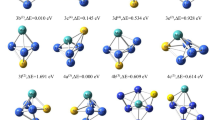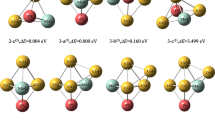Abstract
Context
The investigation of the stability, electronic properties, and catalytic activity of clusters ConMoP holds significant applications and implications in catalyst design, materials science, energy conversion and storage, and environmental protection. The study aims to delve into the unique features of the clusters ConMoP(n = 1 ~ 5), aiming to drive advancements in these related fields. The results obtained from the analysis revealed the stable configurations of the ten clusters, primarily characterized by steric structures. Furthermore, the energy of the clusters was found to increase continuously during growth, as indicated by calculations of atomic fragmentation energy and atomic binding energy. The researchers conducted an analysis of the Natural Population Analysis(NPA) charge, which revealed that Co atoms acted as electron donors, while P and Mo atoms acted as electron acceptors within the clusters. Additionally, an examination of the electrostatic potential indicated that Co and Mo atoms displayed nucleophilic tendencies, while P atoms exhibited electrophilic characteristics. Moreover, the density of states curves, HOMO and LUMO orbitals, and Kooperman's theorem were applied to the clusters ConMoP(n = 1 ~ 5).Through this study, a deeper understanding of the properties and behavior of clusters ConMoP has been achieved, shedding light on their potential as catalysts. The findings contribute to the existing knowledge of these clusters and provide a basis for further research and exploration in this field.
Methods
In this study, we employed the clusters ConMoP(n = 1 ~ 5) to simulate the local structure of the material, enabling us to investigate the stability, electronic properties, and catalytic properties influenced by the metal atoms. By systematically increasing the number of metal atoms and expanding the cluster size, we explored the variations in these properties. Density functional theory (DFT) calculations were performed using the B3LYP hybrid functional implemented in the Gaussian09 software package. The clusters ConMoP(n = 1 ~ 5) underwent optimization calculations and vibrational analysis at the def2-tzvp quantization level, resulting in optimized configurations with different spin multiplet degrees. For data characterization and graphical representation of the stability, electronic properties, and catalytic properties of the optimized configurations, we utilized a range of computational tools. Specifically, the quantum chemistry software GaussView, wave function analysis software Multiwfn were employed. Through the comprehensive utilization of these computational tools, we gained valuable insights into the stability, electronic properties, and catalytic properties of the clusters ConMoP(n = 1 ~ 5) and their dependence on different metal atoms.






Similar content being viewed by others
Data availability
Data sharing not applicable to this article as no datasets were generated or analysed during the current study.
References
Qin Y, Fang ZG, Zhang W, Li LH, Liao W (2020) The study on the catalytic properties of cluster Co3NiB in the hydrogen evolution reaction. J Jiangxi Normal Univ (Nat Sci) 44(01):56–62
Qin Y, Fang ZG, Zhao LL, Liao W, Xu Y (2021) The study on the dynamics and thermodynamicsof isomeric transformation of cluster Co3NiB2 reaction. J Jiangxi Normal Univ (Nat Sci) 45(01):67–74
Fang ZG, Wang ZY, Zheng XX, Qin Y, Mao ZL, Zeng XY, Zhu YW, Wang Q (2022) Study on the dolarizability, dipole moment and density of states of cluster Co3NiB2. J Guizhou Univ (Nat Sci) 39(01):17–24
Zhang YM, Liu Y, Zhao LL, Hou CX, Huang M, Algadi H (2022) Sandwich-like CoMoP2/MoP heterostructures coupling N, P co-doped carbon nanosheets as advanced anodes for high-performance lithium-ion batteries. Adv Compos Hybrid Mater 5(3):2601–2610
Zhang T, Yang TX, Li B, Wai SH, Gao W (2022) Enhancing the electrochemical hydrogen evolution of CoP3/CoMoP nanosheets through the support of black TiO2−x nanotube arrays. J Alloys Compd 905:164165
Zhang TT, Wang YH, Yuan JH, Fang KM, Wang AJ (2022) Heterostructured CoP/CoMoP nanocages as advanced electrocatalysts for efficient hydrogen evolution over a wide pH range. J Colloid Interface Sci 615:465–474
Wu TH, Fang ZG, Wang ZY, Song J, Song JL, Liu LE (2023) The Stable Polarizability of Cluster Co2Mo2P3 Structure. J Jiangxi Normal Univ ( Nat Sci) 47(02):148–153
Lu YK, Zheng XY, Liu Y, Zhu JJ, Li D, Jiang DL (2022) Synergistically Coupled CoMo/CoMoP Electrocatalyst for Highly Efficient and Stable Overall Water Splitting. Inorg Chem 61(21):8328–8338
Chang X, Yan J, Ding XY, Jia YZ, Li SJ, Zhang MY (2022) One-Dimensional CoMoP Nanostructures as Bifunctional Electrodes for Overall Water Splitting. Nanomaterials (Basel) 12(21):3886
Wang YC, Wang YG, Bai J, Lau WM (2021) Trace Amount of NiP2 Cooperative CoMoP Nanosheets Inducing Efficient Hydrogen Evolution. ACS Omega 6(48):33057–33066
Shi JZ, Hou CX, Li L, Xu WC, Fu YB, Huang YZ, Ziyi X, Cheng WJ (2020) Cobalt-Molybdenum Bimetal Phosphides Encapsulated in Carbon as Efficient and Durable Electrocatalyst for Hydrogen Evolution. ChemistrySelect 5(45):14312–14319
Qin W, Wang ZY, Zhao Y, Li FM, Xu L, Wang XM, Jiao H, Chen Y (2020) Self-Supported FeP-CoMoP Hierarchical Nanostructures for Efficient Hydrogen. Evolution 15(10):1590–1597
Huang HW, Cho A, Kim S, Jun H, Lee A, Han JW, Lee J (2020) Structural Design of Amorphous CoMoPx with Abundant Active Sites and Synergistic Catalysis Effect for Effective Water Splitting. Adv Funct Mater 30(43):2003889
Hoa VH, Tran DT, Nguyen DC, Kim DH, Kim NH, Lee JH (2020) Molybdenum and Phosphorous Dual Doping in Cobalt Monolayer Interfacial Assembled Cobalt Nanowires for Efficient Overall Water Splitting. Adv Funct Mater 30(34):2002533
Gong L, Lan K, Wang X, Huang XK, Jiang PB, Wang KZ, Yang M, Ma L, Li R (2020) Carbon-coated Co-Mo-P nanosheets supported on carbon cloth as efficient electrocatalyst for Hydrogen Evolution Reaction. Int J Hydrogen Energy 45(01):544–552
Zhang WG, Liu YH, Zhou HB, Li J, Yao SW, Wang HZ (2019) A high-performance electrocatalyst of CoMoP@NF nanosheet arrays for hydrogen evolution in alkaline solution. J Mater Sci 54(17):11585–11595
Huang XK, Xu XP, Luan XX, Cheng DJ (2020) CoP nanowires coupled with CoMoP nanosheets as a highly efficient cooperative catalyst for hydrogen evolution reaction. Nano Energy 68:104332
Li D, Liu DY, Zhao S, Lu SY, Ma YM, Li MT, Chen GB, Wang YK, Zhou GQ, Xiao CH (2019) Tuning of metallic valence in CoMoP for promoting electrocatalytic hydrogen evolution. Int J Hydrogen Energy 44(59):31072–31081
Thenuwara AC, Dheer L, Attanayake NH, Yan QM, Waghmare UV, Strongin DR (2018) Co-Mo-P Based Electrocatalyst for Superior Reactivity in the Alkaline Hydrogen Evolution Reaction. ChemCatChem 10(21):4832–4837
Alonso JA (2000) Electronic and atomic structure, and magnetism of transition-metal clusters. Chem Rev 100(2):637–678
Chen X, Li Q, Che Q, Chen Y, Xu X (2018) Interface Engineering of Crystalline/Amorphous Co2P/CoMoPx Nanostructure as Efficient Electrocatalysts for Hydrogen Evolution Reaction. ACS Sustain Chem Eng 7(2):2437–2445
Ranjan P, Chakraborty T (2019) Density functional approach: to study copper sulfide nanoalloy clusters. Acta Chim Slov 66(1):173–181
Ranjan P, Chakraborty T (2020) A comparative study of structure, stabilities and electronic properties of neutral and cationic [AuSin]λ and [Sin+1]λ(λ=0,+1;n=1-12) nanoalloy clusters. Mater Today Commun 22:100832
Zeinalipour-Yazdi CD, Cooksy AL, Efstathiou AM (2008) CO adsorption on transition metal clusters: Trends from density functional theory. Surf Sci 602(10):1858–1862
Zl Mao, Fang ZG, Hou QQ, Wang Q, Xu Y, Song JL (2022) The predictive analysis of cluster Co3FeP spectra. J Jiangxi Normal Univ (Nat Sci) 46(1):81–86
Mai WS, Cui Q, Zhang ZQ, Zhang KK, Li GQ, Tian LH, Hu W (2020) CoMoP/NiFe-Layered Double-Hydroxide Hierarchical Nanosheet Arrays Standing on Ni Foam for Efficient Overall Water Splitting. ACS Appl Energy Mater 3(8):8075–8085
Luo SC, Ni D, Li Z, Sun XY, Hu L, Liu XY (2020) Efects of carboxylic acid auxiliary ligands on the magnetic properties of azido-Cu (II) complexes: a density functional theory study. Polyhedron 182:114506
Du JB, Feng ZF, Zhang Q, Han LJ, Tang YL, Li QF (2019) Molecular structure and electronic spectrum of MoS2 under external electric feld. Acta Physica Sinica 68:173101
Kargar H, Behjatmanesh-Ardakani R, Torabi V, Kashani M, Chavoshpour-Natanzi Z, Kazemi Z, Mirkhani V, Sahraei A, TahirMN AM, Munawar KS (2021) Synthesis characterization crystal structures DFT TD-DFT molecular docking and DNA binding studies of novel copper (II) and zinc (II) complexes bearing halogenated bidentate N O-donor Schif base ligands. Polhedron 195:114988
Juárez-Sánchez OJ, Perez-Peralta N, Herrera-Urbina R, Sanchez M, Posada-Amarillas A (2013) Structures and electronic properties of neutral (CuS)N clusters(N=1-6): a DFT approach. ChemPhys Lett 570:132–135
Peng L, Wu SY, Guo JX, Zhong SY, Chen XH (2018) Theoretical investigations on the structural, electronic and spectral properties of VFn(n=1-7) clusters. Zeitschrift für Naturforschung A 73:1091–1104
Haines CRS, Coak MJ, Wildes AR, Lampronti GI, Liu C, Nahai-Williamson P, Saxena SS (2018) Pressure-induced electronic and structural phase evolution in the van der Waals Compound FePS3. Phys Rev Lett 121(26):266801
Ji L, Zeng QX, Wei ML, Jin LW, Zhong QY (2006) J Phys Chem A 110(43):12005–12009
Acknowledgements
Thanks to the National Natural Science Foundation of China and the National Student Innovation and Entrepreneurship Training Program for funding
Funding
This work was supported by National Natural Science Foundation of China Key Project (51634004); National Student Innovation and Entrepreneurship Training Program (202210146008, 202110146027).
Author information
Authors and Affiliations
Contributions
T-H W contributed to writing, data management, methodology. Z-G F contributed to conceptualization, project Management.Z-Y W contributed to article proofreading, data management. L-E L contributed to article proofreading. J-L S contributed to verifcation, methodology. J S contributed to proofreading the article.
Corresponding author
Ethics declarations
Conflict of interest
No potential conflict of interest was reported by the author(s).
Additional information
Publisher's note
Springer Nature remains neutral with regard to jurisdictional claims in published maps and institutional affiliations.
Rights and permissions
Springer Nature or its licensor (e.g. a society or other partner) holds exclusive rights to this article under a publishing agreement with the author(s) or other rightsholder(s); author self-archiving of the accepted manuscript version of this article is solely governed by the terms of such publishing agreement and applicable law.
About this article
Cite this article
Wu, T., Fang, Z., Wang, Z. et al. Stability, electronic and catalytic properties of ConMoP(n = 1 ~ 5) clusters: A DFT study. J Mol Model 29, 269 (2023). https://doi.org/10.1007/s00894-023-05675-5
Received:
Accepted:
Published:
DOI: https://doi.org/10.1007/s00894-023-05675-5




